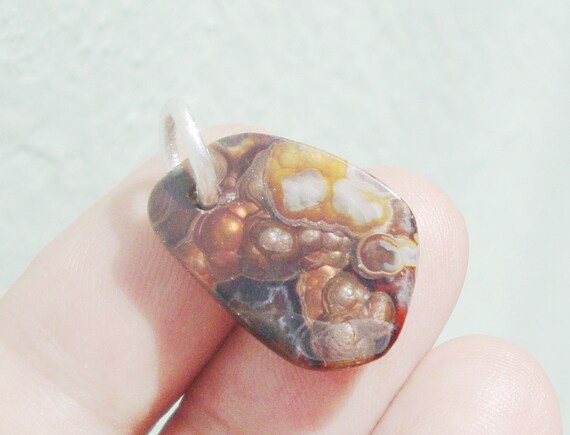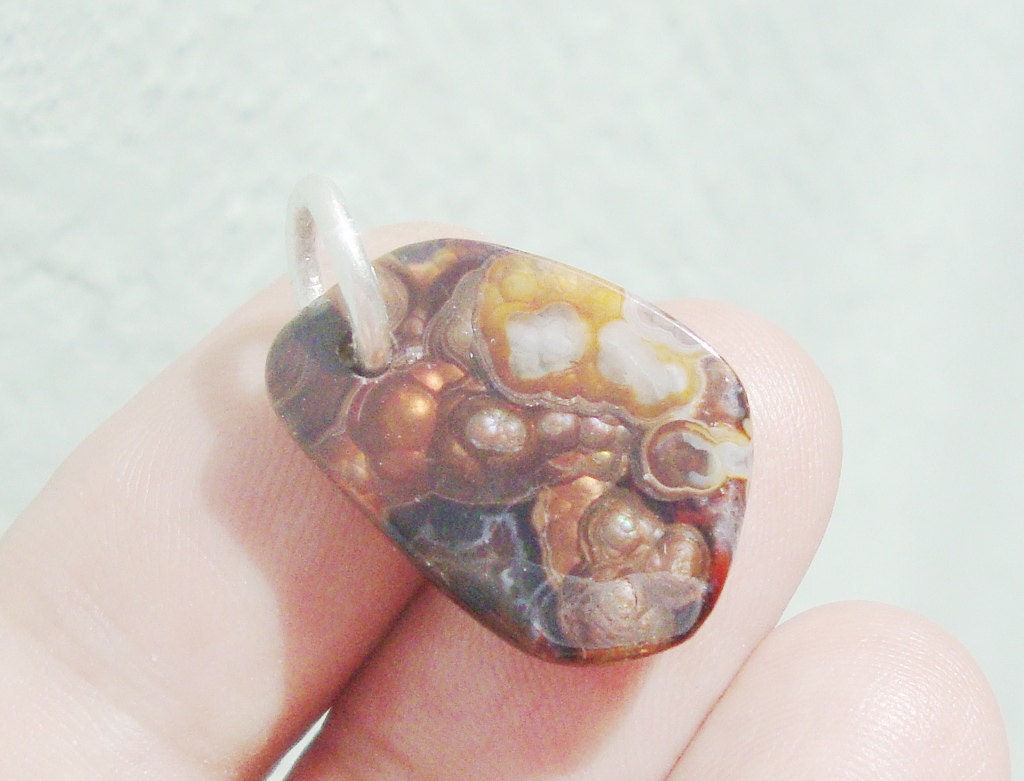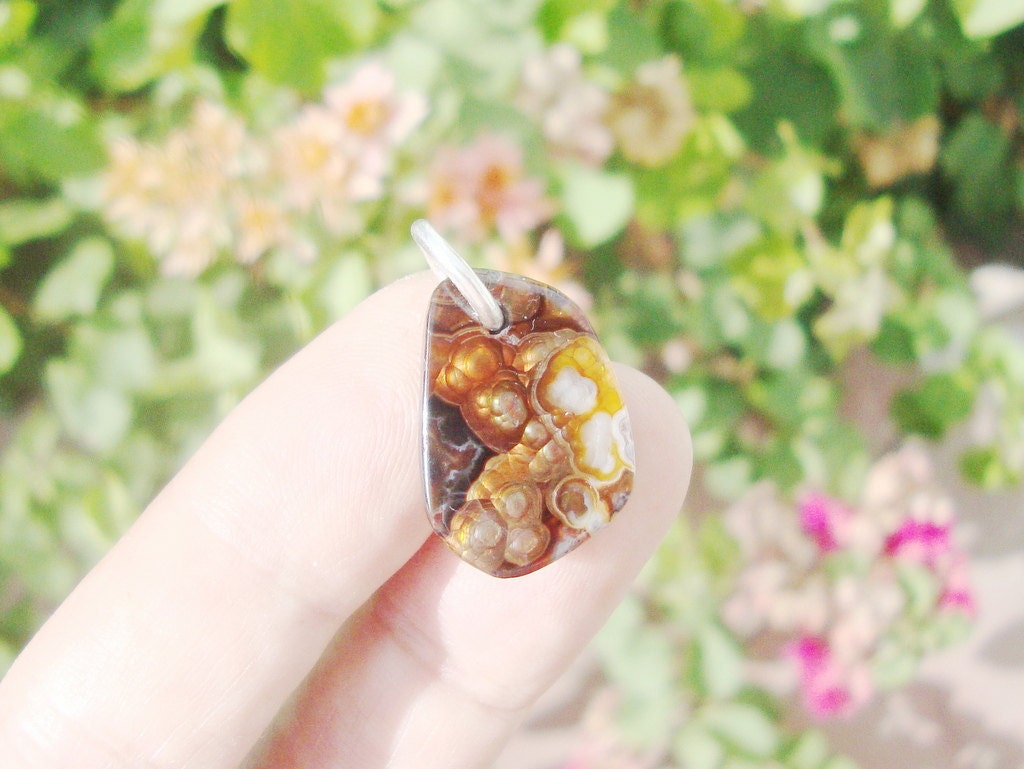Mexican Fire agate cabochon 14.0 cwt. pendant cut
Y5544000
Fire Agates of Mexico Mexico’s agates, particularly banded ones from the country’s Northwest region, such as Laguna, Apache Flame, Iris, Moctezeuma, Crazy Lace, Casas Grandes, Mesquite, Gallego, Coyamito, and Parcelas are well known and highly desired among the world’s afficionados and collectors of fine agates. In my rock/mineral collection, I have specimens of many of the above agates and truly appreciate their numerous colors and uniquely intricate patterns and designs. However, there is one Mexican agate which is not banded that I prize and admire even more highly than those other world class ones- the fire agate, which is only found in the ex-Mexican territories of California and Arizona and in its present states of Chihuahua, Aguascalientes, and San Luis Potosi (with SLP producing only the golden variety). Fire agate, "discovered” post-World War II and commercially mined in Mexico since the early 1960's is the rarest colored gemstone in the world. Much rarer than such precious gemstones as diamonds (which really are not all that rare at all thanks to the cartels that control their supply!), emeralds, and rubies, the much less expensive fire agates, a result of ancient volcanic eruptions, are most commonly formed in the pockets or void spaces of volcanic rhyolite/goethite. These "flashy” agates can most aptly be described as being a rich brown or dark caramel chalcedony (quartz) with patches of iridescent rainbow colors in wavelike, bubbly, and, oftentimes, kidney-shaped surfaces. Their colors may include yellow, gold, green, orange, bronze, purple, and the rarest, most sought after, and, of course, most costly, blue-violet and red; agates that have three or more colors are called "peacock.” Those of high quality can be as striking in their play of color as fine Australian black opals or the rare and precious Mexican fire opals. Moreover, while fire agate colors can be more beautiful (although never as brilliant, as unlike opals whose colors are primary, theirs are secondary as they are imbedded in undulating layers in the host material/chalcedony) than some precious opals these "hard” agates do not run the risk of cracking, fading, or easily scratching as do many opals. Consequently, fire agates are more suitable than opals to be utilized as long wearing jewelry, especially rings, pendants and beads. They are also impressively crafted into creatively designed figurines and sculptures. However, "creating” quality items from this unusual gem is very challenging and potentially problematic due to their unique physical characteristics as they are composed of very thin alternating internal layers of goethite and chalcedony. Accomplished by skilled, resourceful, and imaginative craftsmen, the processes of nature must be reversed through cutting, grinding, and polishing away the multiple curved and wavy layers while painstakingly following the natural contours until only the "fire” is visible. Grinding or polishing slightly too much will destroy the iridescence while trimming just a bit too little will leave "dull” colors- hence, also, no fire. Due to the difficulty of these lapidary processes and the resultant waste of material most high quality fire agate is cut into free form/baroque shapes rather than standard cuts like cabachons; many people, including myself, find the free form much more eye appealing and mystically natural. For reasons that I do not totally understand or agree with, since its introduction into the commercial marketplace as jewelry, fire agate jewelry has been considered by many to be more suitable for men than women; perhaps it is due to the darkness or richness of the quartz that it is surrounded by or perhaps if only the fire agate "industry” had the mass marketing savvy, advertising clout, and cross-cultural influence as does the diamond trade! True, one of my favorite pendants (of the thousand plus) that I have made and wear is a polished piece of "windowed” fire agate with flashes of green, yellow, and orange displayed on a "rough” rhyolite matrix. Yet, my wife, Maria, who normally eschews from wearing jewelry of any kind, when she does wear any will probably be seen with a small exquisite bubbly "tear drop” fire agate pendant with outstanding bursts of green, gold, and reddish orange. At any rate, whatever your preferences may be, Mexico produces two "fire” gemstones that it is famous for, the national gem of the country, the fragile yet colorfully iridescent fire opal and the equally "flashy” yet more durable and more structurally and visually complex fire agate.
Fire Agates of Mexico Mexico’s agates, particularly banded ones from the country’s Northwest region, such as Laguna, Apache Flame, Iris, Moctezeuma, Crazy Lace, Casas Grandes, Mesquite, Gallego, Coyamito, and Parcelas are well known and highly desired among the world’s afficionados and collectors of fine agates. In my rock/mineral collection, I have specimens of many of the above agates and truly appreciate their numerous colors and uniquely intricate patterns and designs. However, there is one Mexican agate which is not banded that I prize and admire even more highly than those other world class ones- the fire agate, which is only found in the ex-Mexican territories of California and Arizona and in its present states of Chihuahua, Aguascalientes, and San Luis Potosi (with SLP producing only the golden variety). Fire agate, "discovered” post-World War II and commercially mined in Mexico since the early 1960's is the rarest colored gemstone in the world. Much rarer than such precious gemstones as diamonds (which really are not all that rare at all thanks to the cartels that control their supply!), emeralds, and rubies, the much less expensive fire agates, a result of ancient volcanic eruptions, are most commonly formed in the pockets or void spaces of volcanic rhyolite/goethite. These "flashy” agates can most aptly be described as being a rich brown or dark caramel chalcedony (quartz) with patches of iridescent rainbow colors in wavelike, bubbly, and, oftentimes, kidney-shaped surfaces. Their colors may include yellow, gold, green, orange, bronze, purple, and the rarest, most sought after, and, of course, most costly, blue-violet and red; agates that have three or more colors are called "peacock.” Those of high quality can be as striking in their play of color as fine Australian black opals or the rare and precious Mexican fire opals. Moreover, while fire agate colors can be more beautiful (although never as brilliant, as unlike opals whose colors are primary, theirs are secondary as they are imbedded in undulating layers in the host material/chalcedony) than some precious opals these "hard” agates do not run the risk of cracking, fading, or easily scratching as do many opals. Consequently, fire agates are more suitable than opals to be utilized as long wearing jewelry, especially rings, pendants and beads. They are also impressively crafted into creatively designed figurines and sculptures. However, "creating” quality items from this unusual gem is very challenging and potentially problematic due to their unique physical characteristics as they are composed of very thin alternating internal layers of goethite and chalcedony. Accomplished by skilled, resourceful, and imaginative craftsmen, the processes of nature must be reversed through cutting, grinding, and polishing away the multiple curved and wavy layers while painstakingly following the natural contours until only the "fire” is visible. Grinding or polishing slightly too much will destroy the iridescence while trimming just a bit too little will leave "dull” colors- hence, also, no fire. Due to the difficulty of these lapidary processes and the resultant waste of material most high quality fire agate is cut into free form/baroque shapes rather than standard cuts like cabachons; many people, including myself, find the free form much more eye appealing and mystically natural. For reasons that I do not totally understand or agree with, since its introduction into the commercial marketplace as jewelry, fire agate jewelry has been considered by many to be more suitable for men than women; perhaps it is due to the darkness or richness of the quartz that it is surrounded by or perhaps if only the fire agate "industry” had the mass marketing savvy, advertising clout, and cross-cultural influence as does the diamond trade! True, one of my favorite pendants (of the thousand plus) that I have made and wear is a polished piece of "windowed” fire agate with flashes of green, yellow, and orange displayed on a "rough” rhyolite matrix. Yet, my wife, Maria, who normally eschews from wearing jewelry of any kind, when she does wear any will probably be seen with a small exquisite bubbly "tear drop” fire agate pendant with outstanding bursts of green, gold, and reddish orange. At any rate, whatever your preferences may be, Mexico produces two "fire” gemstones that it is famous for, the national gem of the country, the fragile yet colorfully iridescent fire opal and the equally "flashy” yet more durable and more structurally and visually complex fire agate.







No hay comentarios:
Publicar un comentario